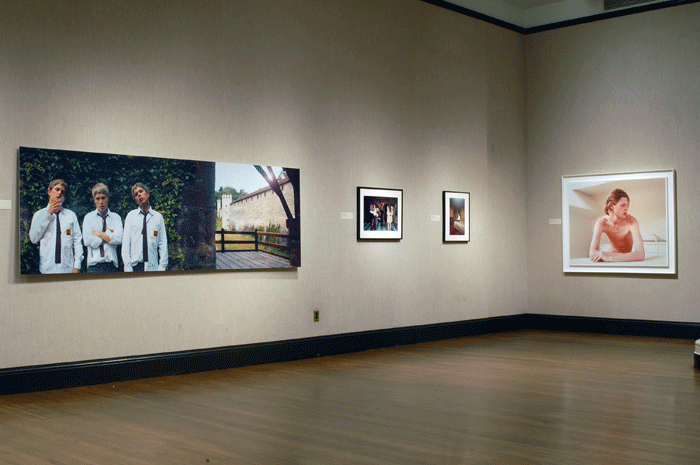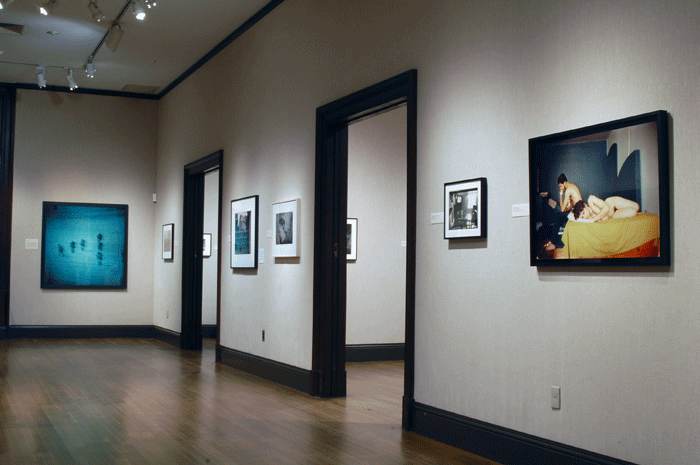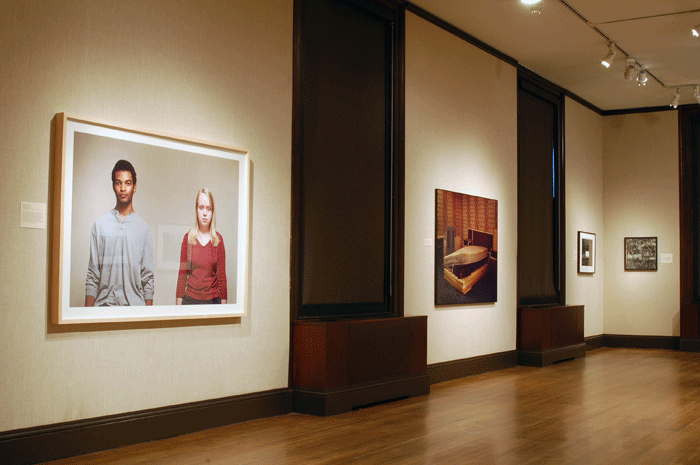Middle Ground: Photographs from the Collection of the Whitney Museum of American Art
January - February, 2006 | The Wallach Gallery at Columbia University, New York
Artists:
Dawoud Bey, Margaret Bourke-White, Kristin Capp, Marianne Courville, Gregory Crewdson, Harold Edgerton, William Eggleston, Robert Frank, Ralph Gibson, Anthony Goicolea, Nan Goldin, Craig Kalpakjian, Louise Lawler, Saul Leiter, An-My Lê, Robert Mapplethorpe, Susan Meiselas, Julie Moos, Gabriel Orozco, Hirsch Perlman, Gilles Peress, Jack Pierson, Melissa Ann Pinney, Michal Rovner, Collier Schorr, Allan Sekula, Stephen Shore, Taryn Simon, Aaron Siskind, Alec Soth, Joel Sternfeld, Hiroshi Sugimoto, Larry Sultan, Arthur Tress, Catherine Wagner, Alexander Dwight Webb, Carrie Mae Weems, Brett Weston, and Garry Winogrand
Overview:
Middle Ground: Photographs from the Collection of the Whitney Museum of American Art challenges the supposition that photography, first and foremost, is a documentary medium. The photographs lead viewers to question photography's relation to time, a viewer's preconceptions about reality, or the delicate balance between presence and absence. Together, these works demonstrate a capacity to suggest aspects of the human experience that are not immediately visible: where reality is transformed into something indefinable, past and present flow into one another, and meaning often lies between what is and what is not seen.



Curatorial Statement:
"The daguerreotype is not merely an instrument which serves to draw nature; on the contrary it is a chemical and physical process which gives her the power to reproduce herself." (n1) Thus Louis Daguerre concludes his introduction to the invention of photography in 1839. From its very inception, photography has been rooted in the documentation of reality. Most often used as a recording medium that captures a singular instant in time and space – albeit selective – photography has the ability to draw attention to a moment that might pass unnoticed, or a scene that might otherwise be dismissed as insignificant. In the words of John Berger, "At its simplest, the message [of photography] decoded means: I have decided that seeing this is worth recording." (n2)
Beyond photography's link to reality, the choices made by a photographer—framing, timing, pose, technology—open the possibility of a meaning broader than a factual depiction of objects in space. Understanding a photograph's potential significance, therefore, often requires an awareness of what lies outside the frame, of that which is not captured. Borrowing words from Gilles Deleuze and Félix Guattari provides a useful way of thinking about photography in relation to this idea:
The middle is by no means an average; on the contrary, it is where things pick up speed. Between things does not designate a localizable relation going from one thing to the other and back again, but a perpendicular direction, a transversal movement that sweeps one and the other away, a stream without beginning or end that undermines its banks and picks up speed in the middle. (n3)
Deleuze and Guattari define the middle as a place that draws its energy and power from the oppositions that surround it. They argue that the middle is not in stasis, but an arena of action and processing. The middle ground is where the process of interpreting a photograph takes place: meaning emerges as the viewer oscillates between reading the detailed information in the image and decoding its deeper significance. Certain photographs have an unusual ability to draw the viewer into this space of contemplation. The photographs in this exhibition lead viewers into a metaphoric space, an ambiguous site for questioning issues of photography's relation to time, a viewer's preconceptions about reality, or the delicate balance between presence and absence in the photographic frame.
A photograph can either isolate a point in a continuum or record duration of time. Gilles Peress's Bloody Sunday, One Minute before First British Paratroop Regiment Fires, Killing Thirteen Civilians, Londonderry, Ireland (1972) exemplifies what the legendary street photographer Henri Cartier-Bresson identified as a "decisive moment." (n4) Within a crowd of demonstrators, figures run in different directions, some men raise their hands in the air; others seem to be caught in midthrow. The title of the work and the chaos depicted suggest where these actions will lead and create a visceral tension in the viewer. Providing details of a specific moment while referencing in the title a climactic conflict in a centuries-old political struggle allows the pain of the event's aftermath to emerge.
Alternatively, Hiroshi Sugimoto, collapses time with a lengthy exposure. In Avalon Theatre (1993), we see a blank screen in an old movie house. The white rectangle, however, is deceivingly vacant. The exposure lasted the full length of a feature film, collapsing the entire visual content of the moving image into a single photographic frame. The artist presents a new reality not otherwise perceivable.
Memory and nostalgia are other poles toward which a photographer can pull an audience. Melissa Ann Pinney's Bat Mitzvah Dance, Chicago, IL (1991) depicts a rite of passage in youth, highlighting the uneasiness of the early teens in an atmosphere of formality that is both touching and humorous. Pinney captures the awkwardness of this time of transition between childhood and maturity. Reading this documentation of adolescence prompts viewers to probe their own memories and understanding of growing up.
Julie Moos also photographs adolescents, but the principle interest is the tendency of the viewer to make assumptions about others based on observations and biases. Drew and Monica (1999-2000), from the series Friends and Enemies, pairs students from a high school in Birmingham, Alabama, a black male and a white female. Moos offers no information about the relationship between the two, nor does their frontal stance or the blank background provide any clues. Instead, viewers—with their individual notions of race, gender and class—are left to speculate on the relationship of the pair. Here, the middle ground is the ambiguous space where viewers vacillate between their own preconceptions and their uncertainty about the actual relationship between the students, which is never revealed.
Although absent information can create ambiguity about the reality depicted, as in the work of Julie Moos, it also possesses the power to convince us of places or events that might not exist at all. André Bazin has written that the photographic image has "an irrational power to bear away our faith." (n5) One can be lulled into believing that the subject of a photograph exists in the physical world even if that existence proves unlikely. Bazin notes that no matter how "lacking in documentary value the image may be" viewers still believe it to bear the mark of the subject it depicts. (n6)
Craig Kalpakjian counts on viewers to bring this faith to his images of pristine office interiors. Lobby (1996) was created within an engineering and architectural design software, FormZ, which allows users to invent spaces that exist entirely in the digital realm. In this image, the wall of mirrors and the florescent lighting are believable elements in a typical corporate lobby. Yet, this particular space is a completely imagined environment, nonexistent in the physical world. The image is given its final, tangible form in the photographic print. Kalpakjian questions our faith in the truthfulness of a photographic image and our tendency to believe what we see.
Gregory Crewdson invents his subjects in a different manner by meticulously staging them. In Untitled (1992) from the series Beneath the Roses a car is halted in the middle of an intersection under a yellow stoplight, door open, no driver. This seems to be a stereotypical main street of Anytown, USA. Yet the dramatic lighting and strangeness of the events imbue the image with a hint of manufactured Hollywood suspense, as in a Hitchcock film. It is precisely the questions that the photograph leaves unanswered that create the ambiguous territory—the middle ground—between reality and fiction. The traces of human presence on a deserted street lead viewers to construct narratives that are not apparent in the picture itself. John Berger suggests that this is an elemental aspect of reading a photograph in which "we are made aware of the poles of absence and presence. Between these two poles photography finds its proper meaning." (n7)
Photography as mediator between presence and absence is at work in Kristen Capp's Picture Holders, Transient Hotel, New York (1964). At first, the image seems void of human presence, but upon closer observation we see methodically placed matchbooks propping up someone's treasured photographs. Capp's depiction of commonplace objects pressed into uncommon service, accentuates the juxtaposition between the inhabitant's construction of home and the transient location. By contrast, the human presence in Nan Goldin's Couple in Bed, Chicago (1977), from her photographic journal, Ballad of Sexual Dependency is central to the image, but it is the absence of connection between these two people that carries significance. Here, a man and a woman are in various stages of undress but their indecipherable expressions and disjointed gazes suggest an uncertain intimacy.
Not all photographs are equal in offering a middle ground for viewers to interpret what they see. The works in this exhibition, by virtue of their subject matter, technique, or composition, call attention to a space similar to what Deleuze and Guattari describe as "a stream without beginning or end that undermines its banks and picks up speed in the middle." These photographs challenge the supposition that photography, first and foremost, is a documentary medium that renders the real through transcription of light. They demonstrate photography's capacity to suggest aspects of the human experience that are not immediately visible: where reality is transformed into something indefinable, where past and present flow into one another, and where meaning often lies between what is and what is not seen.
- Yaelle Amir, Annie Dugan, Jeanne Gerrity, Julie McKim, and Molly Pryor, 2006
Notes:
1 Jacques-Louis-Mandé Daguerre, "Daguerreotype," in History of the Diorama and the Daguerreotype, trans. Annie and Helmut Gernsheim (New York: Dover Publications) 1968. pg 81 2 John Berger, Ways of Seeing (London: British Broadcasting Corporation) 1972. pg 293 3 Gilles Delueze and Félix Guattari, "Rhizome," in A Thousand Plateaus, trans. Brian Massumi (Minneapolis: University of Minnesota Press) 1987. pg 25 4 Henri Cartier-Bresson,. The Decisive Moment (New York: Simon and Schuster, 1952), pg 42, "To me, photography is the simultaneous recognition, in a fraction of a second, of the significance of an event as well as of a precise organization of forms which give that event its proper expression." 5 André Bazin, "The Ontology of the Photographic Image," What is Cinema? vol. 1, trans. Hugh Gray (Berkeley: University of California Press) 1967. pg 15 6 Ibid. 7 Berger, Ways of Seeing, pg 292 "we are made aware of the poles of absence and presence. Between these two poles photography finds its proper meaning."